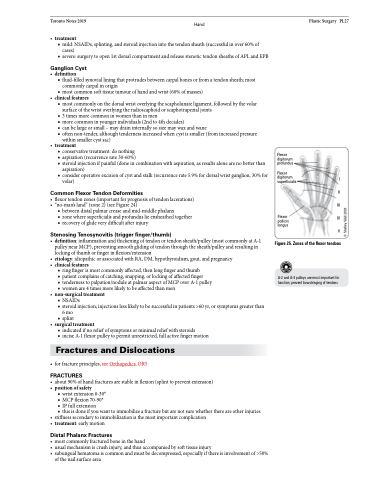Page 1149 - TNFlipTest
P. 1149
Toronto Notes 2019 Hand
• treatment
■ mild: NSAIDs, splinting, and steroid injection into the tendon sheath (successful in over 60% of
cases)
■ severe: surgery to open 1st dorsal compartment and release stenotic tendon sheaths of APL and EPB
Ganglion Cyst
• definition
■ fluid-filled synovial lining that protrudes between carpal bones or from a tendon sheath; most
commonly carpal in origin
■ most common soft tissue tumour of hand and wrist (60% of masses)
• clinicalfeatures
■ most commonly on the dorsal wrist overlying the scapholunate ligament, followed by the volar
surface of the wrist overlying the radioscaphoid or scaphotrapezial joints
■ 3 times more common in women than in men
■ more common in younger individuals (2nd to 4th decades)
■ can be large or small – may drain internally so size may wax and wane
■ often non-tender, although tenderness increased when cyst is smaller (from increased pressure
within smaller cyst sac) • treatment
■ conservative treatment: do nothing
■ aspiration (recurrence rate 30-60%)
■ steroid injection if painful (done in combination with aspiration, as results alone are no better than
aspiration)
■ consider operative excision of cyst and stalk (recurrence rate 5.9% for dorsal wrist ganglion, 30% for
volar)
Common Flexor Tendon Deformities
• flexortendonzones(importantforprognosisoftendonlacerations) • “no-man’sland”(zone2)(seeFigure24)
■ between distal palmar crease and mid-middle phalanx
■ zone where superficialis and profundus lie ensheathed together ■ recovery of glide very difficult after injury
Stenosing Tenosynovitis (trigger finger/thumb)
• definition:inflammationandthickeningoftendonortendonsheath/pulley(mostcommonlyatA-1 pulley near MCP), preventing smooth gliding of tendon through the sheath/pulley and resulting in locking of thumb or finger in flexion/extension
• etiology:idiopathicorassociatedwithRA,DM,hypothyroidism,gout,andpregnancy
• clinicalfeatures
■ ring finger is most commonly affected, then long finger and thumb
■ patient complains of catching, snapping, or locking of affected finger
■ tendernesstopalpation/noduleatpalmaraspectofMCPoverA-1pulley ■ women are 4 times more likely to be affected than men
• non-surgicaltreatment ■ NSAIDs
■ steroid injection; injections less likely to be successful in patients >60 yr, or symptoms greater than 6mo
■ splint
• surgicaltreatment
■ indicated if no relief of symptoms or minimal relief with steroids
■ incise A-1 flexor pulley to permit unrestricted, full active finger motion
Fractures and Dislocations
• forfractureprinciples,seeOrthopedics,OR5
FRACTURES
• about90%ofhandfracturesarestableinflexion(splinttopreventextension) • positionofsafety
■ wrist extension 0-30°
■ MCPflexion70-90°
■ IP full extension
■ this is done if you want to immobilize a fracture but are not sure whether there are other injuries
• stiffnesssecondarytoimmobilizationisthemostimportantcomplication • treatment:earlymotion
Distal Phalanx Fractures
• mostcommonlyfracturedboneinthehand
• usualmechanismiscrushinjury,andthusaccompaniedbysofttissueinjury
• subungualhematomaiscommonandmustbedecompressed,especiallyifthereisinvolvementof>50%
Plastic Surgery PL27
Flexor digitorum profundus
Flexor digitorum superficialis
Flexor pollicis longus
I II III IV V
Figure 25. Zones of the flexor tendons
A-2 and A-4 pulleys are most important for function;preventbowstringingoftendons
of the nail surface area
© Shelley Wall 2003


